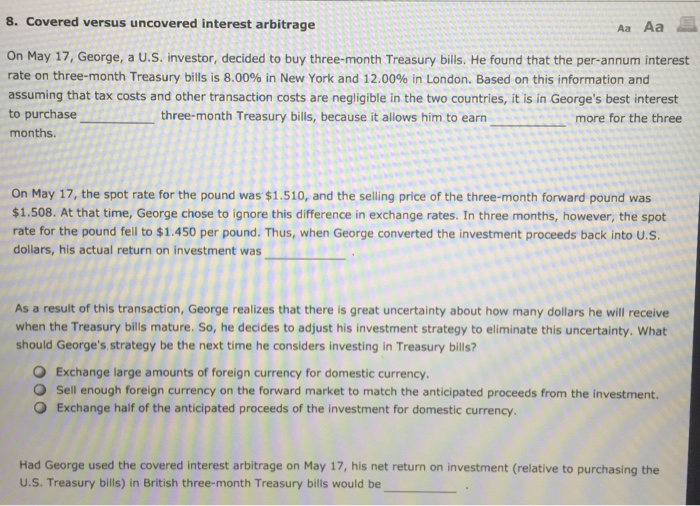Covered versus uncovered interest arbitrage On May 17, George, a U.S. investor, decided to buy three-month Treasury bills. He found that the per-annum interest rate on three-month Treasury bills is 8.00% in New York and 12.00% in London. Based on this information and assuming that tax costs and other transaction costs are negligible in the two countries, it is in George's best interest to purchase______ three-month Treasury bills, because it allows him to earn______ more for the three months. On May 17, the spot rate for the pound was $1.510, and the selling price of the three-month forward pound was $1,508. At that time, George chose to ignore this difference in exchange rates. In three months, however, the spot rate for the pound fell to $1,450 per pound. Thus, when George converted the investment proceeds back into U.S. dollars, his actual return on investment was______. As a result of this transaction, George realizes that there is great uncertainty about how many dollars he will receive when the Treasury bills mature. So, he decides to adjust his investment strategy to eliminate this uncertainty. What should George's strategy be the next time he considers Investing in Treasury bills? Exchange large amounts of foreign currency for domestic currency. Sell enough foreign currency on the forward market to match the anticipated proceeds from the investment. Exchange half of the anticipated proceeds of the investment for domestic currency. Had George used the covered interest arbitrage on May 17, his net return on investment (relative to purchasing the U.S. Treasury bills) in British three-month Treasury bills would be_____. Covered versus uncovered interest arbitrage On May 17, George, a U.S. investor, decided to buy three-month Treasury bills. He found that the per-annum interest rate on three-month Treasury bills is 8.00% in New York and 12.00% in London. Based on this information and assuming that tax costs and other transaction costs are negligible in the two countries, it is in George's best interest to purchase______ three-month Treasury bills, because it allows him to earn______ more for the three months. On May 17, the spot rate for the pound was $1.510, and the selling price of the three-month forward pound was $1,508. At that time, George chose to ignore this difference in exchange rates. In three months, however, the spot rate for the pound fell to $1,450 per pound. Thus, when George converted the investment proceeds back into U.S. dollars, his actual return on investment was______. As a result of this transaction, George realizes that there is great uncertainty about how many dollars he will receive when the Treasury bills mature. So, he decides to adjust his investment strategy to eliminate this uncertainty. What should George's strategy be the next time he considers Investing in Treasury bills? Exchange large amounts of foreign currency for domestic currency. Sell enough foreign currency on the forward market to match the anticipated proceeds from the investment. Exchange half of the anticipated proceeds of the investment for domestic currency. Had George used the covered interest arbitrage on May 17, his net return on investment (relative to purchasing the U.S. Treasury bills) in British three-month Treasury bills would be_____







